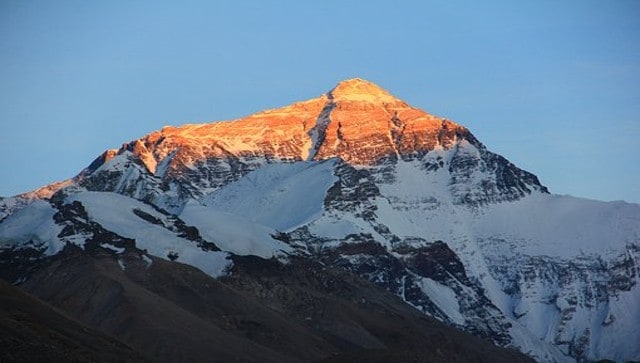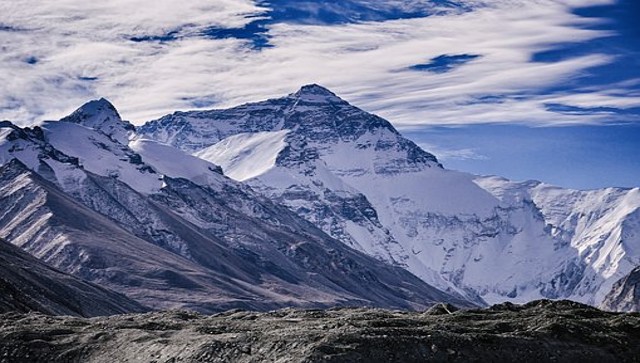Breathtaking Mount Everest has captivated scientists and mountaineers for many years. However, one of its most troubling traits has largely gone unexplored. After sunset, the mountain’s peak’s surrounding high-altitude glaciers erupt with seriously terrifying noises. The cause of those unsettling noises has been discovered by researchers under the direction of glaciologist Evgeny Podolskiy. Let’s take a look. Also read: ‘Highest Ever’: 900 climbers to attempt Everest Summit in 2023
Why Mount Everest makes eerie noises? After spending more than a week hiking in the Nepalese Himalayas in 2018 to test the seismic activity of the Trakarding-Trambau Glacier system there, the team was able to identify the source of the sounds, according to Earth.com. The glaciologist Evgeny Podolskiy and his team of researchers discovered that the high-altitude glaciers’ chorus of smashing and breaking noises is caused by significant dips in temperature after dusk, which cause ice to shatter. Researchers spent over three weeks freezing on the glacier in plain view of Mount Everest, unaware of what was creating the nocturnal sounds, reported Dailymail. [caption id=“attachment_12541702” align=“alignnone” width=“640”] The study published in the journal Geophysical Research Letters suggests local ice turns out to be extremely sensitive to this rapid rate of change. Pixabay[/caption] However, when they returned to sea level and looked at seismographic data, they were able to establish that the extreme cold was the cause. Building on a broad corpus of research into the behaviour of glaciers as the effects of climate change continue to warm the earth, their research was some of the first to indicate such a large quantity of seismic activity caused by the thermal fracturing within the ice. Expedition leader Dave Hahn, who has climbed Everest 15 times, described hearing strange noises as he and other climbers were resting at night, including “ice and rock crashing down in various places around the valley.” ‘It’s tough to sleep,’ he added. Also read: How Mount Everest has been preserving people’s germs from coughs and sneezes
How was the reason discovered? Dr Podolskiy and his colleagues landed on a glacier nearly three miles above sea level, in full view of Everest, which is around 29,000 feet high. “It was a great experience because it’s such a gorgeous environment to work in. Basically, I eat lunch while admiring Everest,” said Dr Podolskiy, who is employed by Hokkaido University’s Arctic Research Centre in Japan. The researchers could work comfortably in t-shirts during the day, however, the temperature dipped to about -15 degrees Celsius, or five degrees Fahrenheit, at night. He and his colleagues realised that their glacier is bursting, or erupting, with cracks at night after hearing “this loud boom” after dark. The scientists utilised the same equipment that is used to gauge earthquake magnitude to install sensors on the ice to measure vibrations deep within the glacier. They gathered seismic vibration data and compared it to wind and temperature data in order to demonstrate a clear link between temperature fluctuations and nocturnal noise, according to the report. The study published in the journal Geophysical Research Letters suggests local ice turns out to be extremely sensitive to this rapid rate of change. The findings may aid more groups of glaciologists and climate specialists in better comprehending how glaciers behave in remote regions, including deep inside the Himalayas, which contain one of the greatest ice deposits on Earth. Also read: Nepal to move Everest base camp. Here’s why
Glaciers melting at a devastating rate Millions of people as well as the economies of South Asian nations are in danger as a result of the Himalayan glaciers melting at an alarming rate. Massive ice sheets in the area have melted 10 times more quickly in the last 40 years than they did over the previous seven centuries, according to Dailymail. According to a study from 2021 published in the journal Scientific Reports, the Himalayan glaciers have lost around 40 per cent of their area over the past few centuries, or 390 to 586 cubic kilometres of ice, which is enough to increase sea levels by 0.92 to 1.38 millimetres globally. With inputs from agencies Read all the
Latest News
,
Trending News
,
Cricket News
,
Bollywood News
, India News
and
Entertainment News
here. Follow us on
Facebook
,
Twitter
and
Instagram
.
The study published in the journal Geophysical Research Letters suggests local ice turns out to be extremely sensitive to this rapid rate of change. Pixabay[/caption] However, when they returned to sea level and looked at seismographic data, they were able to establish that the extreme cold was the cause. Building on a broad corpus of research into the behaviour of glaciers as the effects of climate change continue to warm the earth, their research was some of the first to indicate such a large quantity of seismic activity caused by the thermal fracturing within the ice. Expedition leader Dave Hahn, who has climbed Everest 15 times, described hearing strange noises as he and other climbers were resting at night, including “ice and rock crashing down in various places around the valley.” ‘It’s tough to sleep,’ he added. Also read: How Mount Everest has been preserving people’s germs from coughs and sneezes
How was the reason discovered? Dr Podolskiy and his colleagues landed on a glacier nearly three miles above sea level, in full view of Everest, which is around 29,000 feet high. “It was a great experience because it’s such a gorgeous environment to work in. Basically, I eat lunch while admiring Everest,” said Dr Podolskiy, who is employed by Hokkaido University’s Arctic Research Centre in Japan. The researchers could work comfortably in t-shirts during the day, however, the temperature dipped to about -15 degrees Celsius, or five degrees Fahrenheit, at night. He and his colleagues realised that their glacier is bursting, or erupting, with cracks at night after hearing “this loud boom” after dark. The scientists utilised the same equipment that is used to gauge earthquake magnitude to install sensors on the ice to measure vibrations deep within the glacier. They gathered seismic vibration data and compared it to wind and temperature data in order to demonstrate a clear link between temperature fluctuations and nocturnal noise, according to the report. The study published in the journal Geophysical Research Letters suggests local ice turns out to be extremely sensitive to this rapid rate of change. The findings may aid more groups of glaciologists and climate specialists in better comprehending how glaciers behave in remote regions, including deep inside the Himalayas, which contain one of the greatest ice deposits on Earth. Also read: Nepal to move Everest base camp. Here’s why
Glaciers melting at a devastating rate Millions of people as well as the economies of South Asian nations are in danger as a result of the Himalayan glaciers melting at an alarming rate. Massive ice sheets in the area have melted 10 times more quickly in the last 40 years than they did over the previous seven centuries, according to Dailymail. According to a study from 2021 published in the journal Scientific Reports, the Himalayan glaciers have lost around 40 per cent of their area over the past few centuries, or 390 to 586 cubic kilometres of ice, which is enough to increase sea levels by 0.92 to 1.38 millimetres globally. With inputs from agencies Read all the
Latest News
,
Trending News
,
Cricket News
,
Bollywood News
, India News
and
Entertainment News
here. Follow us on
Facebook
,
Twitter
and
Instagram
.
Mystery Mountain: Why does Mount Everest make seriously terrifying sounds at night?
FP Explainers
• May 3, 2023, 13:53:01 IST
After sunset, Mount Everest’s surrounding high-altitude glaciers erupt with loud noises. A groundbreaking study by glaciologist Evgeny Podolskiy and his team has found that the glaciers’ chorus of spooky noises is because of significant dips in temperature after dusk, which cause ice to shatter
Advertisement
)
End of Article